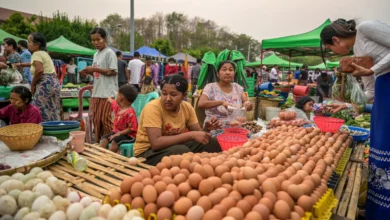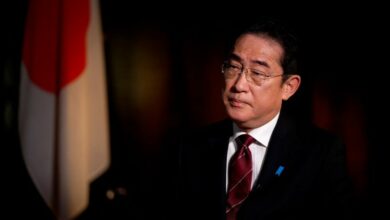Vacation: Leisure time devoted to rest and pleasure.
It was clear from the start that “rest” was not going to be on the agenda for this particular travel adventure. It was also clear that any culinary or cultural “pleasure” would be balanced with bountiful doses of displeasure in the form of long, comfortless bus rides and budget accommodation choices. Would it pay off? Would we regret just skimming the surface? Would it even be possible?
The plan was simple: My travel partner and I were to land in Bangkok, fly our way to Laos’s capital, Vientiane, and circle our way back to Bangkok through northern Laos, head east into Vietnam, cut down to the south, then head back west to Bangkok, through Cambodia. In 21 days.
The first dent to our modest budget came in the form of a US$130 flight from Bangkok to Vientiane, purchased upon arrival in the hopes of reducing travel time. Laos Airlines, with its fleet of small propeller planes may be one the most enjoyable airlines out there, if for no other reason than that there is no safety instruction demonstration.
Vientiane: The planet’s most laid-back capital
For the Egyptian traveler, Laos has a one very special appeal. Forget the sumptuous cuisine, the breath taking landscapes, the kind and gentle people. This is a country where we Egyptians can get a visa after we arrive there, with no bank statements or details of our underwear size necessary.
The first thing we noticed about Vientiane, with its tree-lined boulevards, low-rise buildings, sparse traffic, and assortment of temples and stupas (ancient Buddhist worship sites), was an undeniable quality of timelessness. The kaleidoscopic architecture, which blends classic Lao, Thai, Chinese, French, American, and Soviet styles, combined with the empty and impeccably clean streets, make sections of the city seem as though they are part of some Hollywood studio set up for a film attempting to romanticize the region. The people, always smiley, radiate a c’est la vie approach to life.
The second thing we noticed about Vientiane–and much of Southeast Asia–is the ubiquity of national flags hanging proudly from almost every building. It looks as though the government is trying to willfully foster a sense of nationalism among a people that just couldn’t be bothered with such things. (We’ll get more into that when we talk about the history of Laos.)
As evening settled on our first day in Vientiane, it was time to ascertain the truth about whether this city really offers some of the best and cheapest dining, as our guidebook insisted. The city center is lined with cafés, bakeries and fine dining restaurants serving up traditional, regional and western dishes. We opted for Douang Deuane Restaurant and Wine Bar, which meshed a great traditional atmosphere, superb service from the charismatic French owner, and first-class noodle combinations. The whole meal came to US$14 for the two of us, six of which went to a bottle of fine Chilean wine.
Laos is probably the cheapest country in the region, but you may want to keep a calculator on hand. A dollar is worth about 8500 kip, the local currency. We were millionaires upon arrival.
By 10 PM, as with much of Laos, things were pretty quiet. Nightclubs close early in Vientiane, as the government has imposed a curfew on partying in an attempt to keep the “corrupting” influences of the more liberal Thai from seeping through the country, or so our guidebook suggested. There is a definite sense of government control in this landlocked communist state, where abundant printouts of PDR Law (People’s Democratic Republic) warn against late-night drinking and prostitution.
The next day, we visited Vientiane’s sights, though there aren’t many. Even Pha That Luang, Laos’ most important national symbol, standing tall and golden to symbolize both the Buddhist religion and Lao sovereignty, is not particularly breathtaking once you get up close. It’s definitely worth the visit, at the very least because it costs 35 cents to get in. But beware of the tuk tuk mafia awaiting you outside. Best to bike.
Having only sampled the city, it was still clear that Vientiane is a place where you could easily lose track of what day of the week it is. But with only 19 days left, two days there sufficed.
A sidetrack in history
Once the French empire established its control over Vietnam, the European power embarked on a bit of verbal bullying to convince uncolonized Siam (now Thailand) to give up some land east of the Mekong River. Siam’s concession was the birth of modern Laos. Comprised of dozens of ethnic groups, and many more languages, the French did not seem particularly excited about running Laos. France did little to build up this part of the empire, except allowing opium production to flourish.
Given the diverse ethnic make-up and short history as a nation, it took a while for nationalism to grow in Laos. The first such expression came after the end of World War II, when Japan retreated from Laos and the country united in not wanting the French to come back. The French returned, but only for another eight years. This was followed by a period of rising communist ambitions, which clashed with American fears of a communist region. Finally, and after an 18 year Vietnamese war that saw the US defeated, out of the chaos was born a single party system in Laos supported by Vietnam and China: the People’s Revolutionary Party, the only legal one since 1975.
Vang Vieng
The four hour “VIP” bus ride we took north to Vang Vieng from the capital would have made more conceptual sense if the “P” in VIP had stood for pygmies. A constant pain in the knee, this bus trip left us in a little town that our guidebook suggested was worth a quick stop on the way further north to our next destination, Luang Prabag.
It was worthwhile, just not for anything the town itself offered. Completely consumed by young, party-fueled tourists, the streets were lined with endless bars and cafés, almost all playing reruns of Friends and Family Guy. At first, it was hard to understand: young white men and women running around in swimming trunks and bikinis, sporting strange paint marks on their faces and bodies, blissfully drunk and disorderly. But there is no beach in Laos. Where were these people coming from?
Vang Vieng is, without a doubt, a party town, but most of the action takes places a little north of the river that cuts through the town. Each morning, hundreds of Western youths wake early to take a tok tok ride a few kilometers north, where they get on large rubber rings in the river, and proceed to “pub float” back to town. Yes, the river had pubs.
We decided to go the more “mature” route and kayak down the river the next day. Heading back in the direction of the town after a speedy drive north, we made our way through adrenaline-inducing rapids and stunning green scenery of hilly surroundings. Then suddenly, the scene turned from Lord of the Rings into Lord of the Flies.
In the distance we heard the incongruous thudding of techno, and as we came round a bend, we saw huge wooden platforms on our right and our left rising above the river, holding hundreds of foreigners that were dancing, sliding, swinging–Tarazan style–and tubing from one river pub to the next.
We stopped in one of these ourselves, and braving the chilly water, slid down one of the tiled slides which tossed us far into the river.
Yet there’s much more to do than kayak and drink until you drown around Vang Vieng. Caves dot the city map, and we got on a floating tube in the river and ventured into one of the partially submerged caves. For hundreds of dark meters it stretched deep into hill. We were only able to see what we were floating towards thanks to our head lamps. Beauty and exhilaration–and cold–blended into a unitary experience.
Luang Prabang
Six hours north of Vang Vieng is the picturesque city of Luang Prabang, which attained recognition as a UNESCO World Heritage Site for its unique fusion of Laotian and European architecture. It may be the most beautiful city in Southeast Asia.
Before recounting the beauties of Luang Prabang, let me issue a warning: beware of the “super VIP” bus. Hoping to pass a less painful bus ride further north, we opted for the suspiciously named “super VIP” option. Significantly more expensive than the mere VIP–though ultimately still about US$9–we entered the bus expecting seats that resembled beds. Instead, it was a negligibly cleaner bus with no tourists, where we were shoved into seats at the back of the bus that did not recline. A young sleeping Laotian boy used my thigh as a blanket to cover his seemingly coal-stained feet.
After six nauseating hours of winding roads through dark mountains, we reached Luang Prabang at 2 AM. The deserted streets made ghost towns seem more upbeat at this hour, and knocking the doors of guesthouses bore no results. Finally one opened, and a young man proceeded to tell us that he remembered us and that, yes, our room was ready. We smiled.
Luang Prabang is a tonic for the soul. Nestled on a narrow peninsula where the Mekong meets the Mae Kok River, it is a haven of culinary and architectural delights, with the former of being the best we sampled on our trip.
The best way to see the city is on a bicycle, or a scooter if you are a little more adventurous. You don’t need a license to ride scooters anywhere in Southeast Asia, though don’t attempt leaving an Egyptian ID card as a guarantee for returning the scooter. Much to my dismay, I was told it looked “fake.”
It is, nevertheless, worth leaving your passport if necessary–it seems like a safe and common practice–to rent a scooter and go to Phu Si waterfall, which lies some 30 km out of town. The clear, winding roads offer a fun ride as you whiz by and catch a glimpse into Laotian village life. The falls themselves are breathtakingly idyllic, almost tacky in their suspended beauty. Remember to bring your bathing suit so you can take a dive into the turquoise waters that pool at the bottom of each level of the fantastic waterfall.
Wine is big in Laos, and almost seems like it is government subsidized. Luang Prabang offers excellent and supremely cheap varieties all the way from Australia and Argentina to France and South Africa. You can easily pass away a few evenings at Luang Prabang sitting at the Pac Luc wine bar just people watching and taking in the therapeutic ambiance of the city.
Ultimately, our time in Laos only afforded us short visits to three northern cities, a small piece of a large country of varying landscapes and climates. Did we really see Laos? Certainly not. Though, it depends on what you are after. Much of Laos, some 80 percent of it, is composed of village life that hasn’t changed much over the centuries. For the race ahead of us, we were more than content with what we had managed to squeeze in.
The journey continues in Vietnam, soon.




